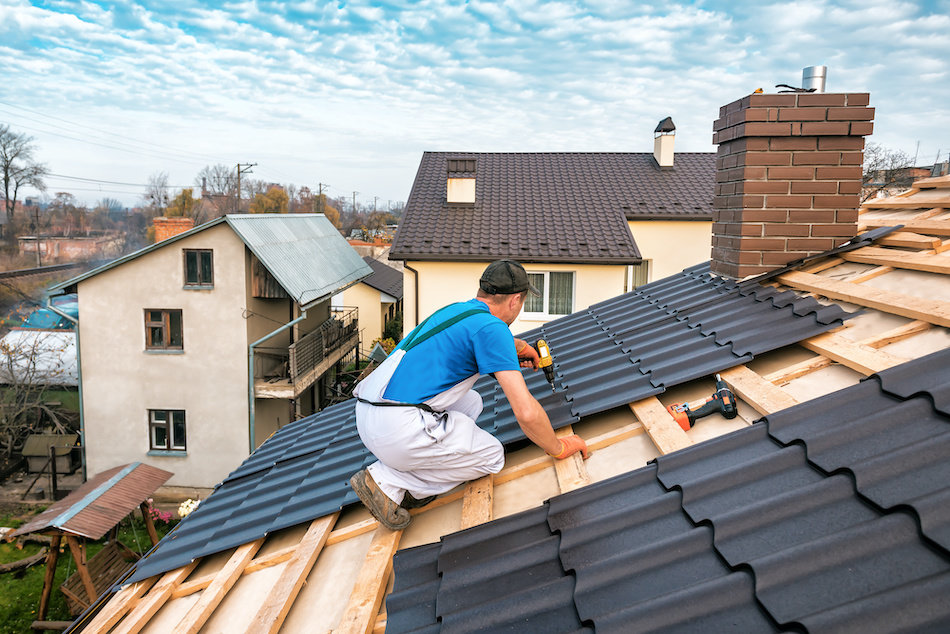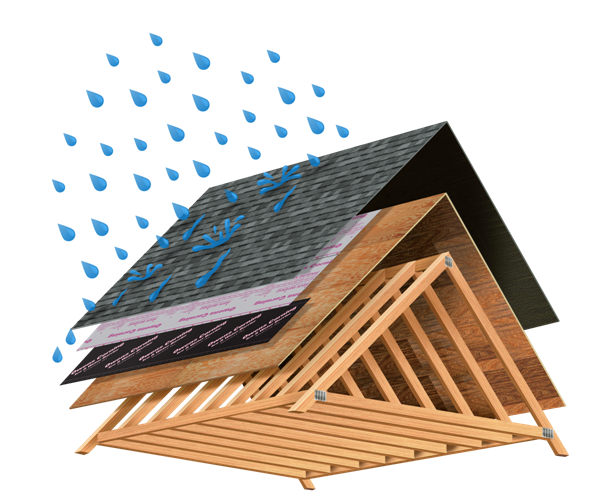Usual Concerns That Can Affect Your Roofing and How to Address Them
Roof covering issues can emerge from numerous aspects, impacting the stability of a home. pleasant hill roofer. Usual problems include leakages, missing out on roof shingles, and bad ventilation. House owners typically neglect these issues till they escalate, causing even more substantial damages. Understanding the options and causes is essential for maintaining a roof's durability. What actions can be taken to prevent these issues from coming to be expensive repairs?
Roof covering Leakages and Their Reasons
Although roofing leakages can emerge from different sources, understanding their main causes is vital for efficient prevention and repair work. One common contributor is the accumulation of particles in valleys and rain gutters, which can block water circulation and cause pooling. Additionally, incorrect flashing around smokeshafts, vents, and skylights can develop powerlessness, allowing water to penetrate. Aging roofing materials additionally play a significant role; as roofing systems age, they may end up being fragile and lose their performance at warding off moisture. Ice dams can develop throughout wintertime months, triggering water to back up under shingles and leakage into the home. Lastly, inadequate air flow can bring about moisture accumulation in the attic room, which might jeopardize the roofing framework gradually. Recognizing these reasons can assist property owners take positive measures to preserve their roof coverings and stop pricey repair services.
Missing or Damaged Tiles
Lots of home owners deal with problems with missing out on or damaged shingles, which can substantially endanger the integrity of a roof. Tiles can become dislodged or deteriorate due to harsh climate condition, age, or inadequate installment. This damage often causes leaks, raised energy prices, and prospective architectural problems if not resolved promptly.To solution this concern, house owners should perform normal inspections of their roof coverings, especially after extreme tornados. Determining missing out on or harmed shingles early can avoid additional complications. If tiles are located to be missing out on, changing them without delay is vital. For minor damage, such as cracks or curling, using roof concrete can give a temporary fix.In situations of extensive shingle damages, a complete roof replacement may be necessary. Consulting with a specialist roofer is advisable to analyze the degree of the damage and suggest the best strategy to ensure the roofing's durability and efficiency.
Poor Roofing Air Flow
Poor roofing ventilation can cause a variety of issues, consisting of excessive warmth build-up and moisture build-up. Property owners might notice indications such as distorted tiles, peeling paint, or mold and mildew growth as indications of poor air flow. roofing contractor in pleasant hill. Dealing with these issues through efficient air flow options can greatly improve the roof covering's life-span and total home comfort
Indications of Poor Ventilation
How can one determine the indicators of poor roofing ventilation? Homeowners may see several signs that direct to bad ventilation in their roof. One usual indicator is the presence of extreme warm in the attic room, typically leading to raised energy prices as cooling systems work more difficult to cool the home. In addition, wetness accumulation might materialize as mold or mold, which can jeopardize both the roofing and indoor air quality. Deforming or staining of roof covering materials can likewise signal insufficient air flow. Ice dam formation throughout winter months might show trapped heat due to not enough ventilation. Recognizing these indications early can assist home owners address ventilation concerns before they escalate right into even more significant roof troubles.
Solutions for Improved Air Flow
To boost roof covering air flow, property owners can apply numerous effective options that advertise much better air movement and minimize warmth buildup. Among one of the most reliable methods is to mount ridge vents, which enable warm air to run away from the optimal of the roof. Furthermore, soffit vents can be mounted along the eaves to attract cooler air into the attic room. Including generator vents or powered attic room ventilators can even more boost blood circulation, particularly in warm climates. Property owners ought to also make sure that insulation is appropriately installed, as it can block air movement if not located properly. Regular evaluations and upkeep, including clearing up debris from vents, are important to preserving effective ventilation and extending roofing life.
Tornado Damage and Its Impact
Tornados can create various kinds of damage to roofing systems, significantly affecting their honesty and long life. Identifying indications of roofing issues without delay is essential for reliable repair and maintenance. Understanding these aspects can help property owners safeguard their buildings against storm-related damages.
Sorts Of Storm Damages
Extreme weather condition events can trigger different sorts of damages to roofings, substantially influencing the honesty of a home. High winds can raise floor tiles or roof shingles, causing subjected areas that may enable water seepage. Hail storm can create damages, splits, or punctures in roofing products, damaging their protective capacities. Hefty rain can intensify existing vulnerabilities, causing leaks and water damage. Additionally, snow buildup can trigger architectural stress and anxiety, potentially causing collapses if not correctly managed. Debris from tornados, such as dropped branches or uprooted trees, can cause significant physical damage too. Comprehending these kinds of storm-related damages is vital for home owners to take prompt activity and guarantee the durability of their roof.
Signs of Roofing Issues
Although lots of property owners might not quickly observe the signs of roof problems, a number of signs can recommend storm damages and its influence. Visible roof shingles that are broken, missing out on, or crinkled frequently show that the roof covering has been jeopardized. Home owners should likewise be cautious for granules in gutters or around the home, as this can indicate roof shingles deterioration. Furthermore, staining or water discolorations on walls and ceilings might recommend leaks stemming from storm-related damage. Sometimes, the existence of mold or mildew can show long term moisture exposure, further emphasizing the seriousness of dealing with roof concerns. Drooping or uneven rooflines can recommend structural problems that may have occurred after extreme weather condition occasions, requiring instant examination.

Repair Work and Upkeep Tips
Resolving roof covering issues without delay can greatly reduce more damage and prolong the lifespan of a roof. Storm damages, such as missing out on leakages or tiles, calls for immediate interest to stop water seepage and architectural concession. Property owners should carry out regular assessments after serious climate occasions to recognize potential damages. If noticeable problems arise, such as sagging or staining, it is recommended to speak with an expert roofing contractor for a detailed assessment. Temporary fixes, like tarps, can supply temporary relief till irreversible repair work are made. Routine maintenance, including cleansing seamless gutters and trimming overhanging branches, can additionally lower the danger of future storm damages. By focusing on these repair work and upkeep suggestions, property owners can improve the longevity and efficiency of their roof.
Mold And Mildew and Mildew Growth
When wetness collects on roof materials, it develops an environment for mold and mildew development. This biological problem can compromise the architectural stability of the roofing and cause substantial health worries for residents because of the launch of spores right into the air. Usual reasons for dampness accumulation include insufficient air flow, leaks, and long term exposure to humidity.To combat mold and mildew and mold, property owners should on a regular basis evaluate their roofing systems for indications of water damage or staining. Applying proper ventilation systems helps in reducing moisture degrees, while quickly addressing leaks is important. Cleaning up the roof covering with appropriate mold-removal remedies can additionally work. In extreme cases, substitute of affected roofing products may be necessary. Regular upkeep and vigilance can avoid mold and mildew and mildew from becoming a consistent issue, making certain both the long life of the roof covering and the health of those living under it.
Buildup of Particles
Mold and mildew are not the only threats to roof materials; the buildup of debris can also position substantial threats. Leaves, branches, and various other natural matter can gather on the roof, causing numerous concerns. When debris blockages rain gutters and downspouts, it avoids correct water drainage, which can cause water merging and prospective leakages. Furthermore, caught moisture can produce a setting conducive to mold and mold development, additional weakening roofing materials.Regular maintenance is vital to minimize these risks. Property owners must periodically check their roof coverings, particularly after storms or high winds, to remove any gathered debris. Cleaning rain gutters and making sure that downspouts are clear will certainly help preserve proper drain. In some instances, employing a professional solution might be advisable to guarantee risk-free and extensive cleaning. By attending to debris build-up immediately, the life expectancy of the roof can be prolonged, protecting the home from additional damages.
Aging Roofing Materials
Aging roofing system materials present a substantial difficulty here for homeowners, as their wear and tear can result in serious architectural concerns. roofing pleasant hill mo. Over time, exposure to extreme weather, UV rays, and temperature fluctuations speeds up wear and tear, decreasing the roof covering's effectiveness. Asphalt tiles might break, curl, or lose granules, while metal roofing systems can create corrosion and deterioration. These issues not only endanger the roof's integrity yet can additionally lead to leakages and water damage inside the home.To address aging roof products, routine examinations are necessary. House owners must seek indicators of wear, such as missing roof shingles or discoloration. Regular upkeep, consisting of cleansing rain gutters and replacing damaged materials, can prolong the lifespan of the roof. In instances of extreme deterioration, a full roofing system replacement may be required. Consulting with a specialist roofer can give an exact evaluation and ideal options tailored to the certain requirements of the home
Frequently Asked Inquiries
Just How Can I Inform if My Roof Needs Replacement?
To establish if a roofing system requires substitute, one must examine for significant wear, missing shingles, leaks, or sagging. Consulting a roof specialist can provide an accurate analysis and support on necessary actions for safety and longevity.
What Are the Indications of a Roof Covering Service Warranty Concern?
Signs of a roofing warranty concern include noticeable leakages, significant wear, or damage not triggered by external variables. Property owners should document concerns and seek advice from the service warranty terms to figure out eligibility for replacements or repair work.
How Commonly Should I Get My Roof Covering Evaluated?
Routine roofing examinations are recommended at least two times a year, ideally in spring and fall. This positive strategy aids determine prospective troubles early, ensuring the roof covering continues to be in excellent condition and prolonging its lifespan.
Can I Do My Own Roof Repair works?
The individual pondered the possibility of executing their own roof repairs. While some small tasks may be manageable, caution is recommended; inappropriate repair work can cause considerable concerns, calling for professional help for security and effectiveness.
What Is the Typical Life Expectancy of Various Roof Covering Materials?
